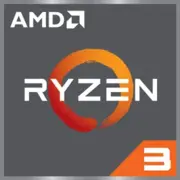AMD Ryzen 3 PRO 5475U

AMD Ryzen 3 PRO 5475U: Budget Processor for Work and Everyday Tasks
March 2025
Introduction
In 2025, the mobile processor market continues to evolve rapidly, but not all users are willing to pay a premium for top-tier chips. The AMD Ryzen 3 PRO 5475U remains a relevant choice for those seeking a balance between performance, energy efficiency, and price. This processor, released back in 2022, is still commonly found in budget ultrabooks and business laptops. Let's explore who this model is suitable for and what tasks it can handle.
Architecture and Technology
Zen 3 and 7nm Process: Basis of Stability
The Ryzen 3 PRO 5475U is built on the Zen 3 architecture (codename Cezanne-U) and is manufactured using the TSMC 7nm FinFET process. This ensures high transistor density and energy efficiency.
- 4 cores and 8 threads thanks to SMT (Simultaneous Multithreading).
- Base frequency: 2.7 GHz, maximum in Turbo mode: 4.1 GHz.
- Cache memory: 8 MB L3, which accelerates the processing of frequently used data.
- Integrated Radeon graphics with 6 compute units (384 stream processors) and a frequency of up to 1.6 GHz.
Architecture features:
- Improved IPC (instructions per cycle) by 19% compared to Zen 2.
- Supports DDR4-3200 and LPDDR4X-4266 RAM.
Power Consumption and TDP
15W for Mobility
The processor's TDP is 15W, making it ideal for thin laptops.
- Operating modes: Depending on the load, the system dynamically adjusts frequency and voltage. For example, when working in Chrome, the processor reduces frequency to 1.2 GHz to minimize heat.
- Temperature regime: Even under load, the chip rarely exceeds 75°C, allowing for silent operation without loud coolers.
Power-saving technologies:
- Precision Boost 2 – automatic core "overclocking" when thermal headroom is available.
- AMD PowerNow! – adaptive power management to extend battery life.
Performance in Real Tasks
Office, Multimedia, and Light Gaming
Geekbench 6:
- Single-Core: 1638 points.
- Multi-Core: 4254 points.
Use Scenarios:
1. Office Tasks (Word, Excel, Zoom):
- Working simultaneously with 15+ browser tabs and a PDF editor – no lags.
2. Multimedia:
- Converting a 30-minute video to 1080p using HandBrake: ~22 minutes.
- Streaming 4K on YouTube: stable, with CPU usage at 30-40%.
3. Gaming:
- CS:GO at low settings: 45-55 FPS at 1080p.
- Genshin Impact (720p, minimum settings): 30-35 FPS.
- Indie Titles (Hollow Knight, Stardew Valley): 60 FPS without issues.
Turbo Mode:
Under short bursts of load (e.g., opening a "heavy" Excel file), the frequency rises to 4.1 GHz, reducing response time. However, during sustained loads (over 5 minutes), the system reverts to base values to prevent overheating.
Use Case Scenarios: Who is the Ryzen 3 PRO 5475U Suitable For?
1. Students and Office Workers:
- Working with documents, online courses, video conferences.
2. Budget-Conscious Users:
- Laptops based on this processor range from $500-700 (new models in 2025).
3. Corporate Sector:
- PRO series chips support AMD PRO Security technologies (data encryption, attack protection).
Not Suitable For:
- Gamers looking to play AAA titles.
- Video editors working with 4K footage.
Battery Life: How Long Will the Battery Last?
With a battery capacity of 50 Wh (typical for ultrabooks):
- Video playback: Up to 9 hours.
- Browsing the web: 6-7 hours.
- Power-saving mode: +1.5-2 hours.
Optimization:
- Adaptive Brightness – automatic screen brightness adjustment.
- Core Parking – disabling unused cores during idle times.
Comparison with Competitors
AMD vs Intel vs Apple
1. Intel Core i5-1235U (10 cores, 12 threads, TDP 15W):
- Better for single-threaded tasks (Geekbench 6 Single-Core: ~1800), but worse for multi-threaded tasks (Geekbench 6 Multi-Core: ~4000).
- Laptop prices: starting at $600.
2. Apple M1 (8 cores, 7nm):
- Leader in energy efficiency (up to 15 hours of battery life) but has limited compatibility with Windows software.
- Laptops with M1: starting at $800 (new models are no longer produced but are available for sale).
3. AMD Ryzen 5 5625U (6 cores, 12 threads):
- 25% more powerful in multitasking but more expensive ($700-900).
Summary: The Ryzen 3 PRO 5475U is optimal for Windows devices priced under $700.
Pros and Cons
Strengths:
- Low power consumption and quiet operation.
- Sufficient performance for everyday tasks.
- Support for modern standards like Wi-Fi 6 and USB4.
Weaknesses:
- No support for PCIe 4.0 (only PCIe 3.0).
- Integrated graphics are weaker than Intel Iris Xe.
Laptop Selection Recommendations
1. Type of Device:
- Ultrabooks (Acer Swift 3, Lenovo ThinkPad E14).
- Budget laptops (HP ProBook 445 G9).
2. What to Pay Attention To:
- RAM: Minimum of 8 GB, preferably 16 GB.
- Storage: SSD 512 GB (NVMe preferred).
- Display: Full HD, IPS panel.
3. Avoid:
- Laptops with HDD instead of SSD.
- Models without USB-C ports.
Final Conclusion
The AMD Ryzen 3 PRO 5475U is a solid choice for those seeking an affordable laptop for work, study, or browsing. It offers adequate performance, quiet operation, and up to 9 hours of battery life. However, for gaming or professional tasks, it is advisable to consider models with Ryzen 5/7 or a discrete graphics card.
Who is it Suitable For:
- Students.
- Office workers.
- Users who value a balance between price and quality.
Key Benefits:
- Reliability and security of the PRO series.
- Energy efficiency.
- Affordable pricing.
If you're looking for a "daily use" laptop without frills, the Ryzen 3 PRO 5475U is worth adding to your shortlist.
Basic
CPU Specifications
Memory Specifications
GPU Specifications
Miscellaneous
Benchmarks
Compared to Other CPU
Share in social media
Or Link To Us
<a href="https://cputronic.com/en/cpu/amd-ryzen-3-pro-5475u" target="_blank">AMD Ryzen 3 PRO 5475U</a>